![]()
Shen-Hao HZX4x5-II, A Large Format Field Camera
And a short introduction to large format
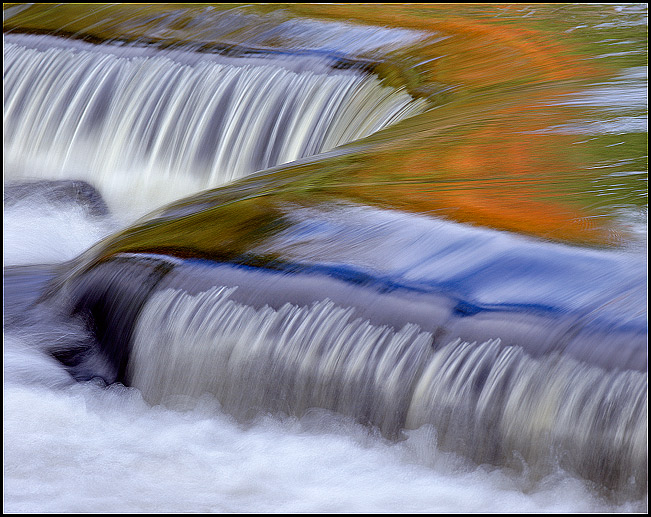
Rapids near Bond Falls, Upper Michigan
Why Large Format?
With the convincing of Danny Burk who also shoots 4x5, I decided to return to large format after a year hiatus (a one year affair with a Hasselblad Xpan). It was hard deciding what camera to get. Initially, I wanted to get a Toyo 45CF because it was selling for a low price. It is a very light camera made of carbon fiber and plastic. I heard many positive and negative reports about the camera. The biggest negative being a lack of certain movements which were important to me. After researching many sites online, I came across reviews of the Chinese made Shen-Hao camera. I then discovered that Badger Graphic in Kaukauna, WI stocked the camera for a reasonable $625. I went up there and looked at it and ended up coming home with one.
Large format allows you to slow down and methodically perform every aspect of image making. You have control over metering, focus and composition. Another advantage is the large film area. You are talking 4"x5" of film to render even the most minute detail. Thirteen times the size of 35mm film! Grain virtually disappears on a print of any size up to 40"x50". Detail is what it is all about. On the left is the full image and on the right is a 100% crop:
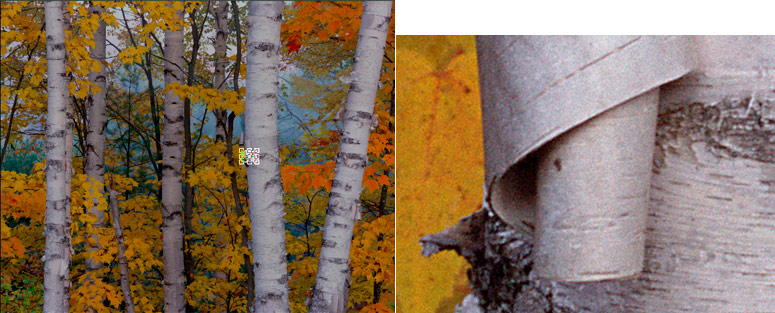
At a bare minimum to start in 4x5 you need a camera body, lens, film holder, dark cloth for focusing, meter and a tripod.
Camera

The camera is built with teak wood and stainless steel. The Shen-Hao comes in a natural wood finish (seen here) and also comes painted black. I first had a black model but it shows wear a bit more. Build quality is good. The camera is sturdy and stable. All of the controls are easy to turn and when locked down make the camera pretty rigid.
Set up is a snap. Taking only minutes to unfold and shoot if speed is important. The camera folds into a pretty compact size when through shooting.
The ground glass (where you focus the image) is reasonably bright with normal and long lenses. Wide lenses can sometimes be a problem to focus as with any large format camera. A bag bellows is available for wide lenses though I regularly shoot with a 65mm with the included bellows. The camera takes Linhof style boards.

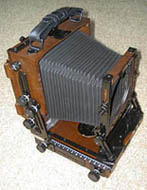
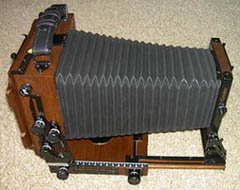
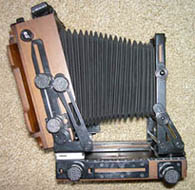
What makes the Shen-Hao stand out are the versatile back movements. Not only does it have rear tilt, but it has rear rise, shift, and swing. Many features you would find on more expensive field cameras. One other feature is you can slide the whole rear standard forward about 70mm. This provides great balance with wide angle lenses such as my 65mm and reduces the chance of the bed viginetting. Also, by tilting the rear standard back and tilting the front standard forward, I was able to use the Nikkor-T* 500mm telephoto lens on the Shen-Hao. It just barely fits (the Bond Falls image at the begining of the article was taken with the 500mm).
By tilting the back, you can alter the plane of focus. Tilt the back to the rear and you extend the apparent depth-of-field from near the camera to near infinity. You also exaggerate the size of whatever is in your foreground. This is nice if you want a looming foreground. By swinging the back to the right or left, you can extend the point of focus along a fence or other object.
The camera also has front tilt and swing for even more control of your image.
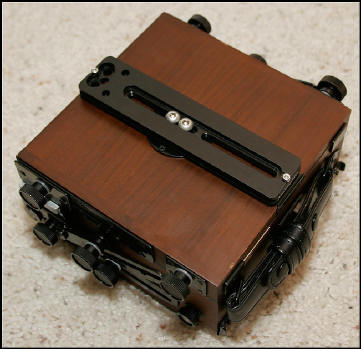
Lupe
For focusing the the ground glass I use a Toyo 3.6x lupe. It is small, light and a bargain at $40 new. While shooting, it is hung around my neck.
Meter
In the past I used another camera for metering of large format. That was very cumbersome and meant I had to carry extra weight. I finally sprung for a handheld meter with my new large format purchase. The Sekonic L-608. Probably the best light meter money can buy. It is small and light. It can be used as a spot meter or an incident meter all in one device.

Lenses
The Shen-Hao can use lenses as wide a 47mm and up to about 300mm. It can also use up to the Nikkor-T* 500mm telephoto lens by extending the front and rear standards out to gain a few cm of extra reach. Popular large format lenses are made by Schneider Kreuznach, Rodenstock, Nikon (Nikkor), and Fujinon. Each of the lenses needs to get mounted into a Linhof/Wista style lens board to allow mounting to the camera. To get a rough idea of how large format lenses compare to 35mm, divide the LF lens focal length by 3. Here are lenses that I currently use:
Schneider Super Angulon 65mm f/5.6
Equivalent to about 22mm in 35mm terms. Shown with the appropriate Schneider Center Filter. An excellent choice for dramatic near/far images.
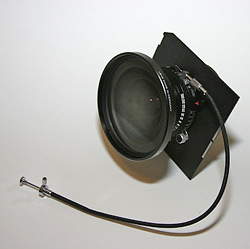
Schneider Super Angulon 90mm f/5.6
Equivalent to about 30mm in 35mm terms. A great general wide angle lens. This lens gets the most use.

Nikkor-W 150mm f/5.6
Equivalent to about a 50mm in 35mm terms. I use this lens for landscapes as well as for close-up photography. A great normal lens.
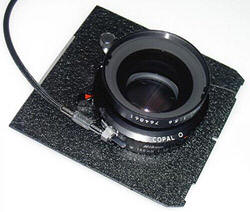
Schneider Symmar-S 210mm f/5.6
Equivalent to about a 70mm in 35mm terms. Considered a longish normal lens. This lens is good for brining in farther objects.
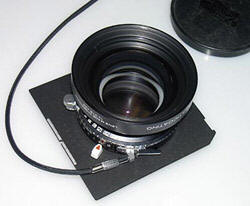
Nikkor-M 300mm f/9
Equivalent to about 100mm in 35mm terms. Great for things that are a little out of reach.
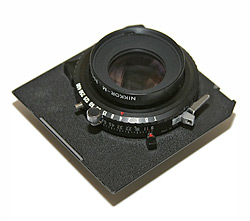
Each lens gets its own cable release. This speeds up shooting time. I do keep two spares in one of the pockets of the bag because you never know...
How I Pack My Large Format Equipment
How is all of this stuff carried? The Lowepro Minitrekker makes a nice home for my large format equipment. The bag filled tips the scales at about 30 pounds. Not too bad. You can see I have no more room... Attached to one of the outer straps is my dark cloth which is a black t-shirt.
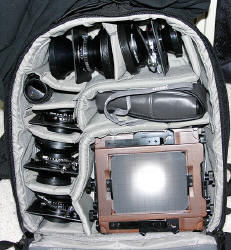
Shen-Hao 6x17 Roll Film Back-A great accessory for shooting 6x17cm panoramic images.
![]()